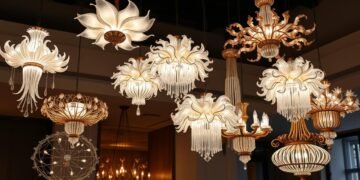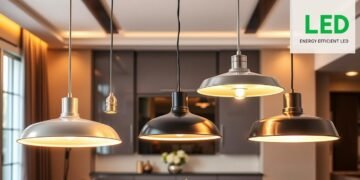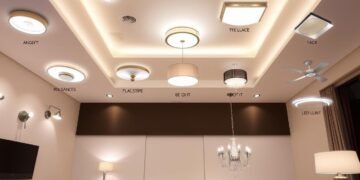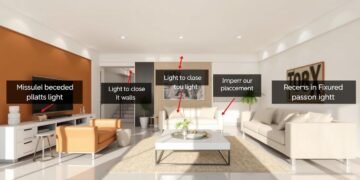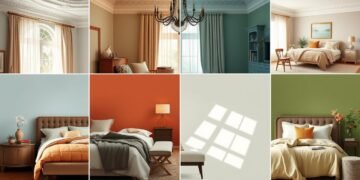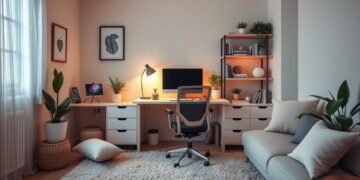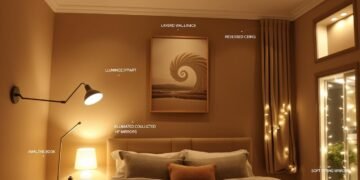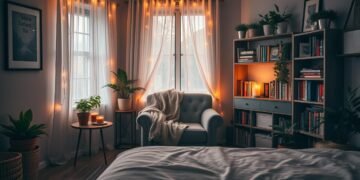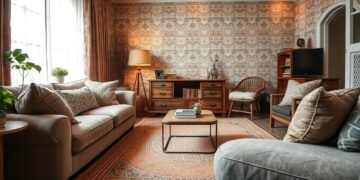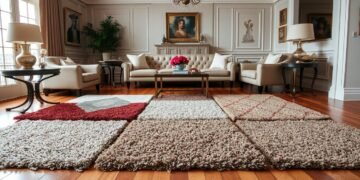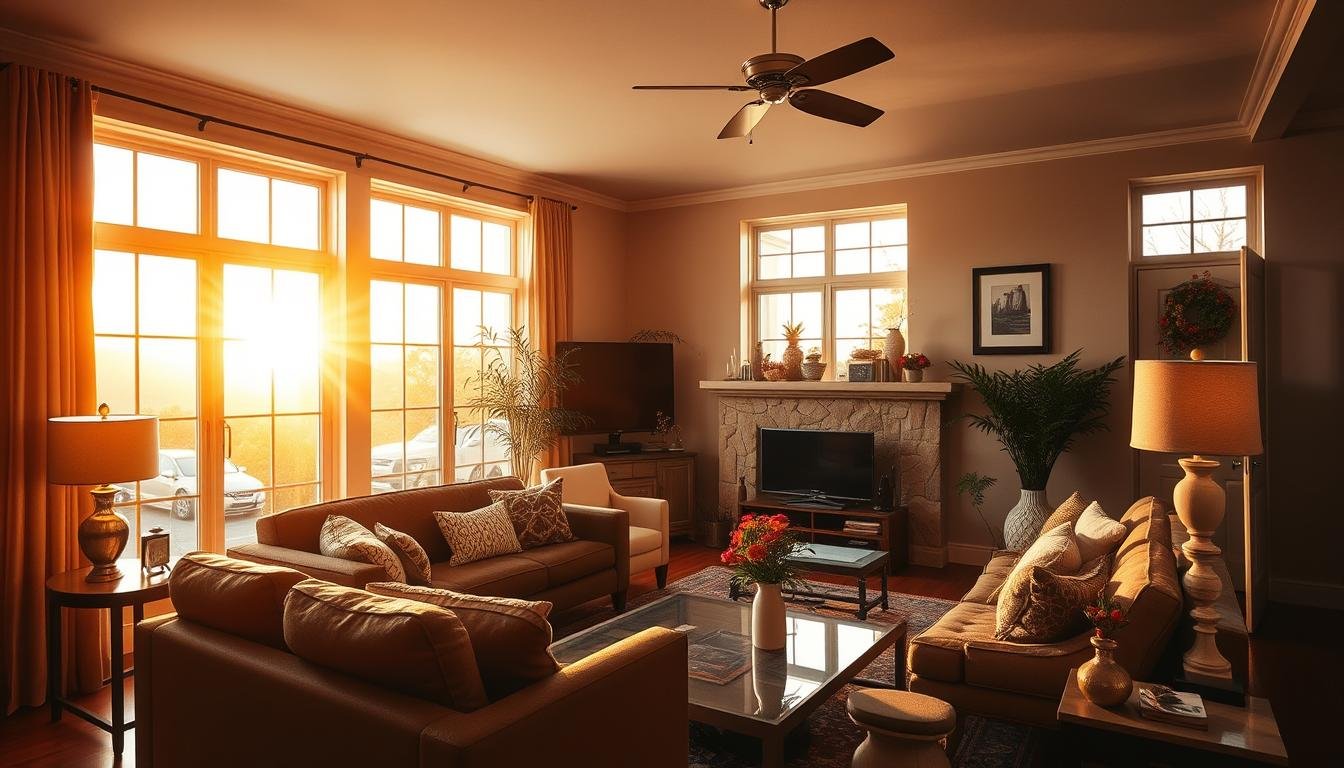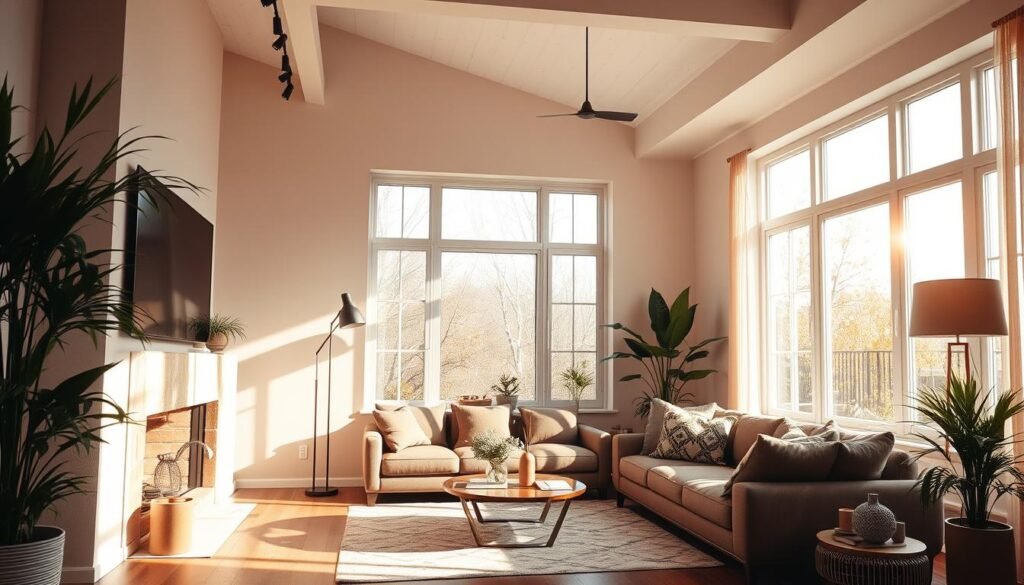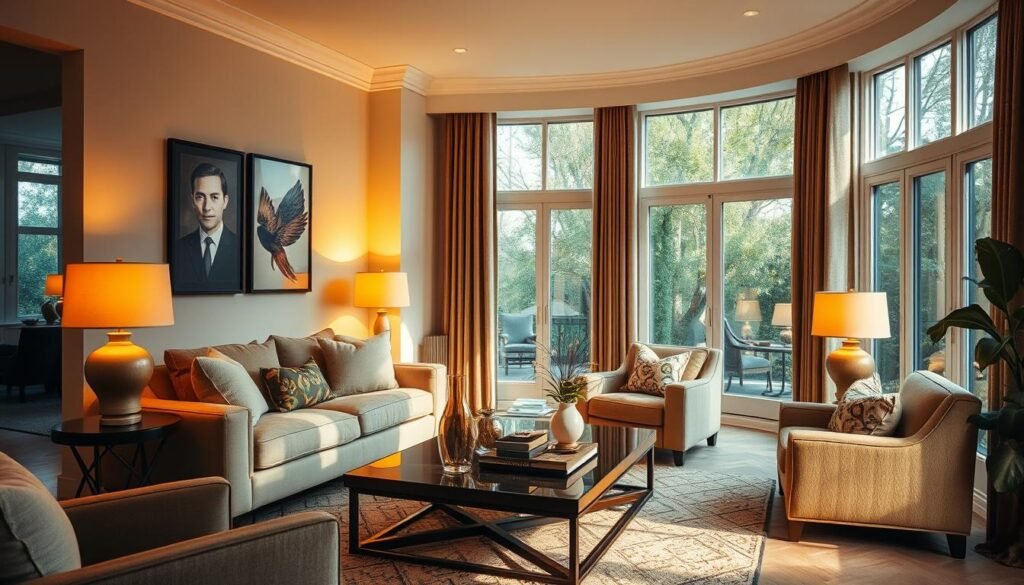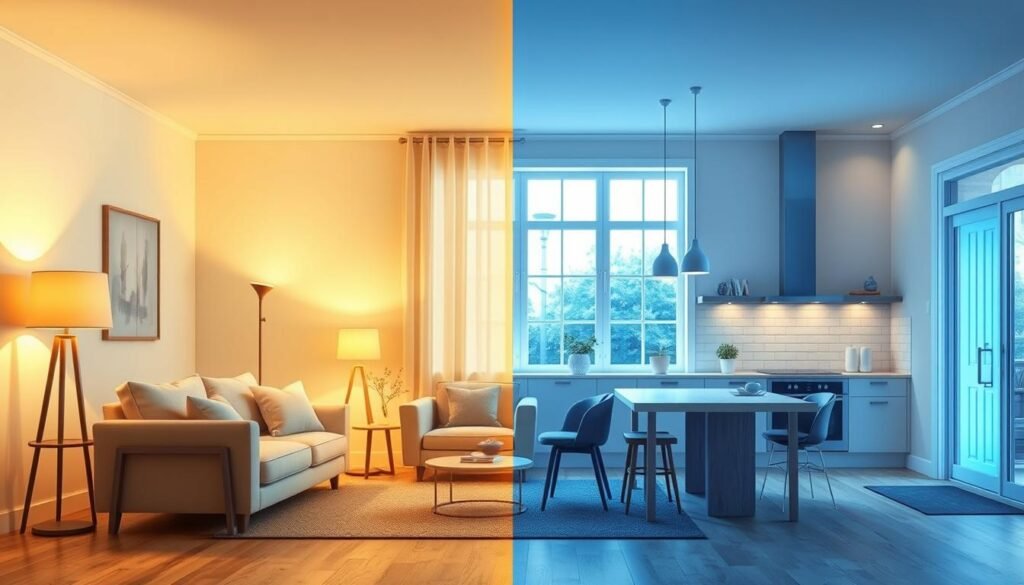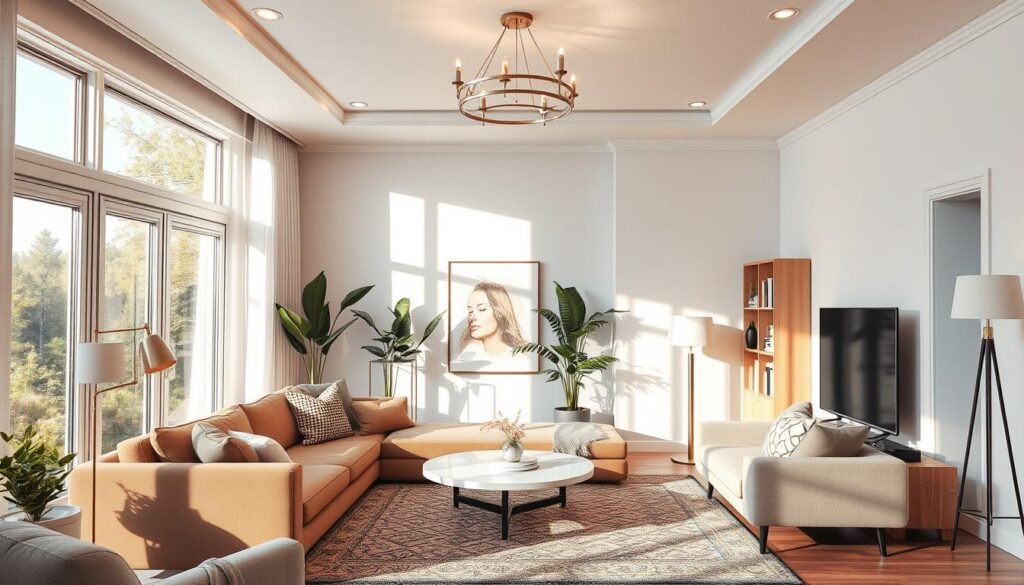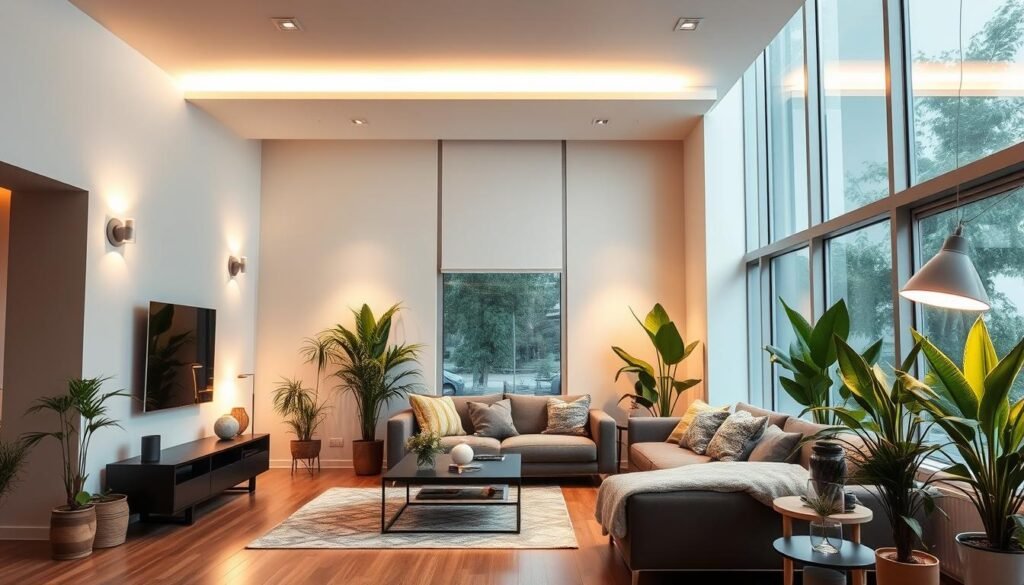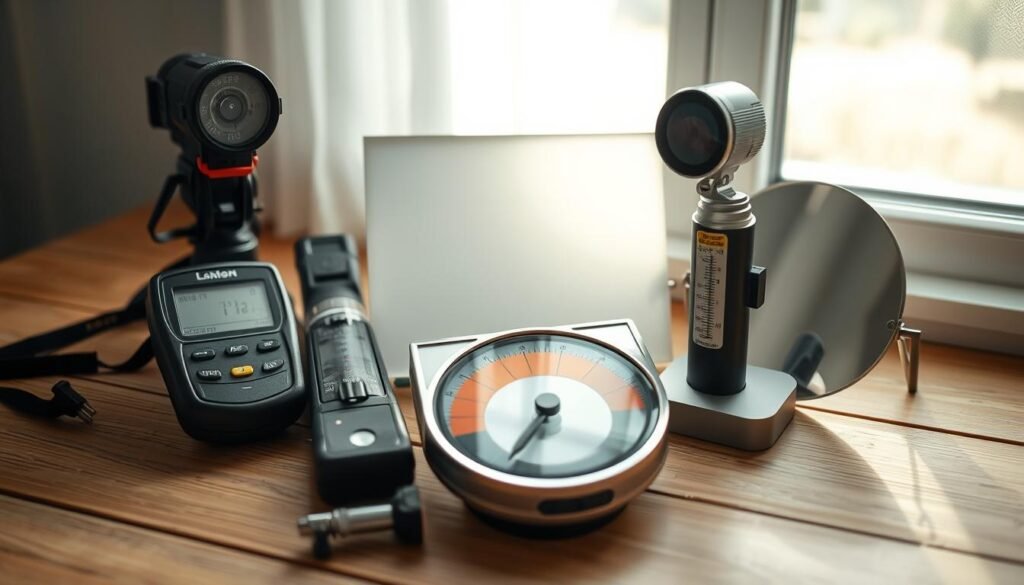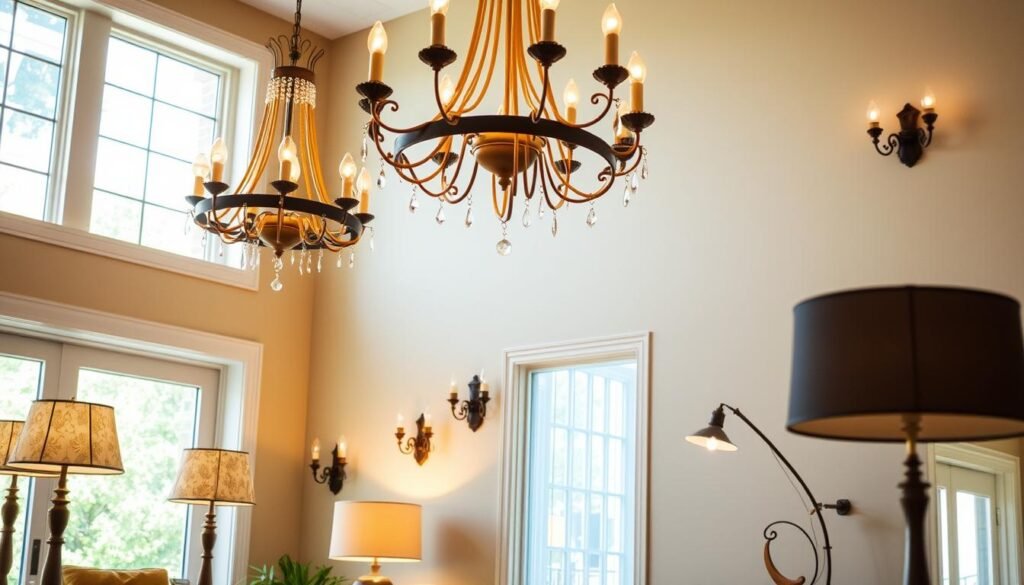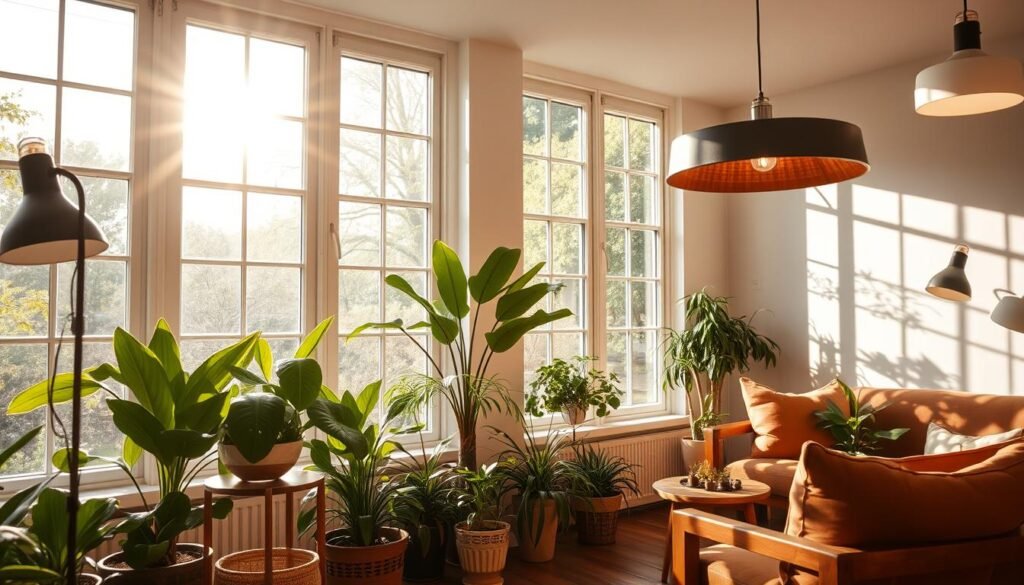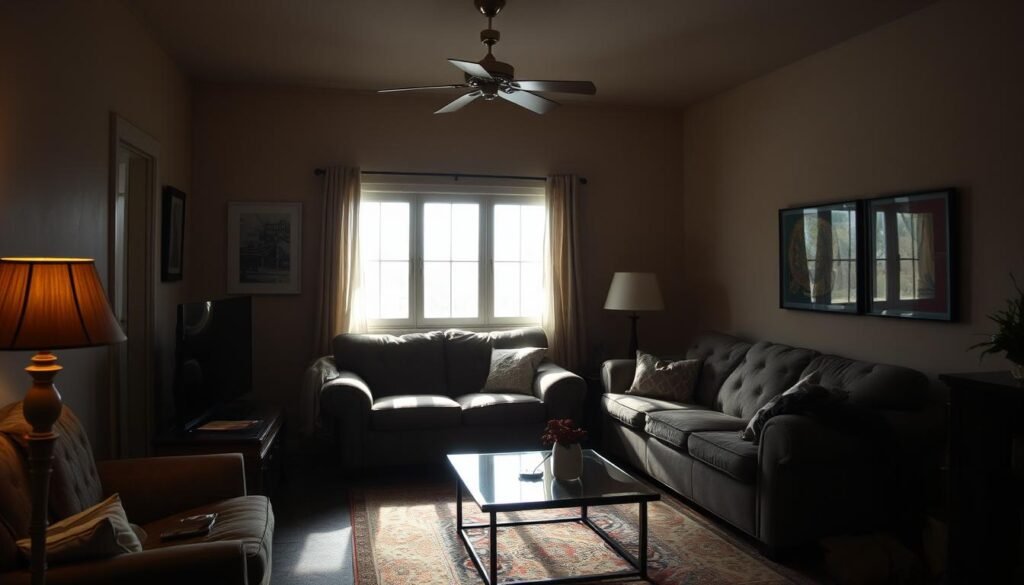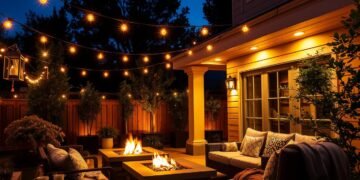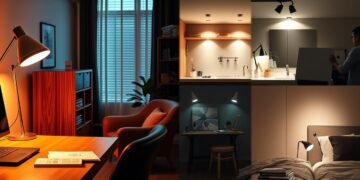Imagine walking into a friend’s new home and feeling the warmth. The living room is lit softly, and lamps highlight cozy spots. Every room feels just right, neither too bright nor too dark. This is what happens when you master lighting.
Lighting design is more than just turning on a light. It’s an art that changes your space. By mixing natural and artificial light, you make your home both useful and uplifting. The right light makes every moment special, whether you’re reading or having guests over.
In this guide, we’ll cover 12 key lighting basics. You’ll learn how to balance natural and artificial light. Discover how to make your home both beautiful and practical. Let’s find your dream home’s lighting!
Table of Contents
- 1 Understanding Light’s Impact on Home Design
- 1.1 The Psychology of Light in Living Spaces
- 1.2 Relatedarticles
- 1.3 7 Sustainable Lighting Options for an Eco-Friendly Home
- 1.4 6 Ideas for Outdoor & Patio Lighting to Extend Your Living Space
- 1.5 7 Methods to Incorporate Task Lighting for Greater Functionality
- 1.6 How Light Affects Mood and Productivity
- 1.7 The Balance Between Function and Aesthetics
- 2 Essential Lighting Fundamentals for Home Design
- 3 The Three Pillars of Interior Lighting
- 4 Natural Light Optimization Techniques
- 5 Color Temperature and Light Quality
- 6 Strategic Lighting Placement for Different Rooms
- 7 Energy-Efficient Lighting Solutions
- 8 Understanding Light Measurement
- 9 Lighting Controls and Automation
- 10 Decorative Lighting Elements
- 11 Light Layering Techniques
- 12 Sustainable Lighting Practices
- 13 Common Lighting Mistakes to Avoid
- 14 Conclusion
- 15 FAQ
- 15.1 What are the three pillars of interior lighting?
- 15.2 How does light affect mood and productivity?
- 15.3 What is color temperature in lighting?
- 15.4 How can I optimize natural light in my home?
- 15.5 What are lumens and lux in lighting?
- 15.6 What are the benefits of LED lighting?
- 15.7 How can I create a layered lighting design?
- 15.8 What are some common lighting mistakes to avoid?
- 15.9 How can I make my home lighting more sustainable?
- 15.10 What lighting levels are recommended for different rooms?
- 15.11 How does smart lighting enhance home illumination?
- 15.12 What is the importance of Color Rendering Index (CRI) in lighting?
- 16 Source Links
Key Takeaways
- Proper lighting design enhances comfort and functionality in your home
- Balancing natural and artificial light creates a harmonious living environment
- Understanding light’s impact on mood and productivity is key for home design
- Incorporating ambient, task, and accent lighting layers adds depth to your space
- Energy-efficient options like LED and smart systems offer both savings and control
- Avoiding common lighting mistakes can dramatically improve your home’s ambiance
Understanding Light’s Impact on Home Design
Light is key in making your home spaces special. It can change how your home feels and works. We’ll look at how light psychology affects your home and the balance between function and beauty.
The Psychology of Light in Living Spaces
Light psychology shapes your home’s feel. Natural light makes you feel alive and happy. Soft, warm light makes your home cozy.
The right light can make rooms feel bigger and more welcoming. It can even help you sleep better.
How Light Affects Mood and Productivity
The light in your home can change how you feel and work. Bright, cool lights help you stay focused and alert. They’re great for work areas.
Warm, dim lights help you relax. They’re perfect for unwinding in the evening. Using different lights can make your home better for different times of the day.
The Balance Between Function and Aesthetics
Finding the right lighting is about mixing function and beauty. Task lighting helps with specific tasks. Accent lighting makes your home’s features stand out.
Ambient lighting brings it all together, making your home feel nice. It’s all about layering these lights for a space that works and looks good.
| Lighting Type | Function | Examples |
|---|---|---|
| Task Lighting | Focused illumination for specific activities | Under-cabinet lights, desk lamps |
| Accent Lighting | Highlights features or creates focal points | Wall sconces, picture lights |
| Ambient Lighting | Overall illumination for the room | Ceiling fixtures, recessed lights |
Knowing about lighting can make your home beautiful and useful. The right mix of light can turn your home into a place that’s both lovely and practical.
Essential Lighting Fundamentals for Home Design
Learning about lighting basics is key to a well-designed home. The right lighting can change how you feel, work, and enjoy your space. Knowing about light distribution and how to light up areas can make a big difference.
- Light types: Incandescent, fluorescent, and LED
- Color temperature: Measured in Kelvins
- Color Rendering Index (CRI): Rates color accuracy
- Energy efficiency: Look for Energy Star ratings
- Lighting controls: For flexibility and accessibility
LED lights are the most energy-efficient and last the longest. They work by lighting up when voltage is applied. This makes them great for many lighting needs in your home.
Color temperature is important for mood. Warm lights (lower Kelvins) are great for homes and bedrooms. Cool lights are better for offices. The Color Rendering Index helps pick bulbs that show colors well, aiming for a score of 80 or higher.
| Light Type | Efficiency | Lifespan | Best Use |
|---|---|---|---|
| Incandescent | Low | Short | Being phased out |
| Fluorescent | Medium | Medium | General lighting |
| LED | High | Long | Versatile, energy-saving |
Think about the types of fixtures you’ll use, like pendants, chandeliers, and recessed lighting. Your lighting should match your furniture and colors for a unified look.
The Three Pillars of Interior Lighting
Creating a well-lit home is all about layered lighting. This method uses three main types of light to make your space both functional and beautiful. Let’s dive into the essential parts of good interior lighting.
Ambient Lighting: Creating the Base Layer
Ambient lighting is the first step in lighting up your home. It makes sure the space is well-lit and comfortable. You can use recessed lights, chandeliers, or ceiling lights for this.
These lights have a housing, trim, and bulb. Together, they create a soft, even light all over the room.
Task Lighting: Functional Illumination
Task lighting is for areas where you do activities. It’s great for reading, cooking, or working. In kitchens, under-cabinet lights are perfect, and over dining tables, pendant lights work well.
These lights can move or adjust to shine exactly where you need it. This makes your home more functional.
Accent Lighting: Adding Drama and Depth
Accent lighting adds personality and interest to your space. It highlights special features, art, or decorations. Track lights, wall-mounted lights, and linear stair lights are great for this.
By placing accent lights carefully, you can focus attention on certain areas. This creates a stunning atmosphere.
By mixing ambient, task, and accent lighting, you can make any room welcoming and versatile. Each type should have its own switch. This lets you change the mood and use of your space as the day goes on.
Natural Light Optimization Techniques
Natural light optimization changes home design. It’s not just about letting sunlight in. It’s about making spaces feel alive and vibrant. By focusing on window placement and daylight penetration, you can make your home bright and energy-efficient.
Window Placement and Size Considerations
Strategic window placement is key to harnessing natural light. South-facing windows capture the most sunlight, making them ideal for living areas. Use larger windows in these spaces to maximize light intake. For privacy-sensitive areas like bathrooms, frosted windows allow light while maintaining seclusion.
Maximizing Daylight Penetration
To enhance daylight penetration, keep windows unobstructed. Use light-filtering blinds or sheer curtains instead of heavy drapes. In kitchens, place sinks or workspaces under windows to benefit from natural light while performing tasks. For home offices, position desks near windows to boost productivity with natural illumination.
Managing Glare and Heat Gain
Effective glare management and heat gain control are key for comfort. Install adjustable window treatments to regulate light intensity. Consider using light-colored surfaces near windows to reflect and diffuse incoming light, reducing glare. For heat control, explore options like low-E glass or exterior shading devices to minimize unwanted solar gain during hot months.
By implementing these natural light optimization techniques, you’ll create a home that’s not only brighter but also more energy-efficient and comfortable. Remember, the goal is to balance light abundance with practical considerations for a truly harmonious living space.
Color Temperature and Light Quality
Understanding color temperature and light quality is key to perfecting your home’s ambiance. The Kelvin scale shows color temperature, with lower numbers giving warmer light and higher numbers cooler tones. This helps you pick the right lighting for each space and activity.
- Warm light: 3500K or less
- Neutral light: 3500K to 4100K
- Cool light: 4100K or higher
For indoor use, a color temperature between 2700K to 3600K is best. Cool light (3600-5500K) is great for tasks because it has high contrast. Warm light (2700-3000K) makes living spaces cozy.
The Color Rendering Index (CRI) rates light quality from 1 to 100. A CRI of 80 or above is good for most homes. Higher CRI means colors look more natural and vibrant.
| Light Source | Color Temperature (K) | Application |
|---|---|---|
| Warm White LED | 2700-3000 | Living rooms, bedrooms |
| Cool White LED | 3600-5500 | Kitchens, offices |
| Daylight LED | 5500-6500 | Art studios, detailed work |
By looking at both color temperature and CRI, you can make a lighting plan that looks good and works well.
Strategic Lighting Placement for Different Rooms
Lighting in each room is key to the perfect atmosphere in your home. Knowing what each space needs helps improve both looks and function.
Living Room Lighting Solutions
The living room needs flexible lighting for different activities. Aim for 100-150 lux for basic light, and dim to 50 lux for a cozy feel. Use floor lamps, table lamps, and overhead lights to layer your lighting.
Kitchen and Dining Area Illumination
Kitchens need bright, focused lighting for safe food prep. Make sure work areas have at least 400 lux. Dining areas should have 150-200 lux, but can go up to 400-500 lux for other uses. Think about pendant lights over islands and under-cabinet lights for more function.
Bedroom and Bathroom Lighting Strategies
Bedrooms should have soft, adjustable lighting, from 50-150 lux. Use indirect lights like LED strips or spotlights for a calm feel. Bathrooms need 250-300 lux for general light, with task lights near mirrors for grooming.
| Room | Recommended Lux | Lighting Types |
|---|---|---|
| Living Room | 100-150 (dimmable to 50) | Floor lamps, table lamps, overhead fixtures |
| Kitchen | 400+ (work surfaces) | Task lighting, under-cabinet lights, pendants |
| Dining Area | 150-200 (up to 500 for tasks) | Pendant lights, dimmable overhead lights |
| Bedroom | 50-150 | Indirect lighting, bedside lamps, dimmable overheads |
| Bathroom | 250-300 (general), task lighting for mirrors | Vanity lights, overhead lights, shower lights |
Customizing your lighting for each room makes your home both beautiful and practical. It adjusts to your needs and moods every day.
Energy-Efficient Lighting Solutions
Lighting is key in home design, affecting both looks and energy use. Today’s energy-saving lighting mixes style with green living. Let’s dive into how LED tech and smart lights are changing how we light our homes.
LED Technology Benefits
LEDs have changed the lighting world for the better. They use less power, last longer, and shine brighter than old bulbs. LEDs also come in many colors, letting you set the mood in any room.
- LEDs use up to 75% less energy than incandescent bulbs
- They can last up to 25 times longer than traditional lights
- LED bulbs emit less heat, reducing cooling costs in your home
Smart Lighting Systems
Smart lighting systems take energy saving further. They mix LED tech with smart controls, making it easy to change your home’s lighting. You can adjust brightness, color, and set schedules with your phone or voice.
Smart lighting’s main features include:
- Remote control via mobile apps
- Motion sensors for automatic on/off
- Integration with home automation systems
- Energy usage tracking and reporting
| Lighting Type | Energy Efficiency | Lifespan | Smart Features |
|---|---|---|---|
| Traditional Incandescent | Low | 1,000 hours | None |
| LED | High | 25,000+ hours | Basic dimming |
| Smart LED | Very High | 25,000+ hours | Full customization |
Choosing energy-saving lights and smart systems makes your home bright and green. These solutions are perfect for today’s homeowner, blending function and style.
Understanding Light Measurement
Light measurement is key to the perfect home ambiance. Knowing about lumens, lux, and light intensity helps you choose the right lighting.
Lumens show how much light a source gives off. For example, a 100-watt incandescent bulb has about 1,700 lumens. Lux, on the other hand, measures light on a specific area. It’s always linked to a distance, like 2450 lux at 0.5 meters.
| Environment | Light Level (Lux) | Light Level (Footcandles) |
|---|---|---|
| Bright Summer Day | 100,000 | 10,000 |
| Full Daylight | 10,000 | 1,000 |
| Overcast Day | 1,000 | 100 |
| Traditional Office | 300-500 | 30-50 |
| Common Stairway | 50-100 | 5-10 |
In an average room, 7,500 lumens is usually enough. This means about 600-1000 lux on a surface. Understanding these concepts helps you get the right light balance. This prevents dark or overly bright spots in your home.
Lighting Controls and Automation
Lighting controls and automation have changed how we light our homes. They bring flexibility, save energy, and add functionality. Now, you can control your lights from anywhere with apps or voice commands.
Dimming Systems and Controls
Dimming systems let you adjust light levels for any mood. Advanced LED lights offer color and brightness control. This can save 24-38% on energy, cutting down costs.
Smart Home Integration
Smart home integration elevates lighting control. Lights can turn on when you enter a room or adjust with daylight. This boosts convenience and saves energy. Sensor controls use motion and light to cut down bills.
Scene Setting Capabilities
Scene setting lets you save lighting setups for various activities. With a button, change your space from work mode to relaxation. Integrated systems offer customization and advanced features.
| Smart Lighting Device | Average Cost | Installation Time | Key Benefits |
|---|---|---|---|
| Smart Plugs | $50 ($25-$150) | Less than 10 minutes | Energy monitoring, compatibility |
| Smart Bulbs | $40-$80 ($15-$150) | Easy screw-in installation | Color changing, wireless connectivity |
| Smart Switches | $55 ($40-$70) | Professional installation required | Full lighting connectivity, geofencing |
Embracing lighting controls and automation does more than just brighten your home. It makes your living space more efficient, comfortable, and tailored to your needs.
Decorative Lighting Elements
Decorative lighting turns your home into a stunning place. By picking the right lighting, you can make your space both beautiful and useful. Let’s see how to make your home stand out with great lighting.
Chandeliers are perfect for entryways, welcoming everyone. Wall sconces light up hallways and living rooms nicely. Floor lamps add warmth to corners, and table lamps create cozy spots for reading.
LED strips under shelves or furniture add depth to your room. They can highlight special features or make furniture look like it’s floating. Lighted coffee tables and furniture make any room look more elegant, combining beauty with usefulness.
| Decorative Lighting Element | Benefits | Best Placement |
|---|---|---|
| Chandeliers | Makes a bold statement | Entryways, dining rooms |
| Wall sconces | Good light distribution | Hallways, living areas |
| Floor lamps | Creates warm focal points | Corners, reading nooks |
| LED strips | Adds depth to design | Under shelves, furniture |
| Illuminated furniture | Merges form with function | Living rooms, bedrooms |
Getting the right balance is key in decorative lighting. Use different types of lights to create layers of light. This makes your space both beautiful and practical. With careful choice and placement, you’ll create a home that shines brightly.
Light Layering Techniques
Light layering makes dull spaces lively by adding depth and interest. It uses many light sources to make a room well-lit and interesting. By learning light layering, you can highlight features, change a room’s feel, and make it safe and cozy.
Creating Depth Through Multiple Light Sources
To get lighting depth, use three main types: ambient, task, and accent lighting. Ambient lighting gives overall light, often from ceiling lights like chandeliers. Task lighting is for work areas, and accent lighting shines on special spots.
In a kitchen, Savoy House Alden pendants work for tasks, with under-cabinet lights adding more. In a living room, a chandelier can be ambient, with wall sconces lighting up art.
Balancing Light Intensity Levels
Getting light levels right is essential for light layering. Make sure each layer’s brightness is balanced to avoid too much or too little light. Dimmers help adjust light levels for different moods at different times.
| Lighting Layer | Purpose | Common Fixtures |
|---|---|---|
| Ambient | General illumination | Chandeliers, pendants, flush mounts |
| Task | Workspace lighting | Floor lamps, table lamps, under-cabinet lights |
| Accent | Highlight features | Wall sconces, track lighting, LED tape |
By mixing these layers smartly, you make a lighting plan that boosts both function and beauty in your home. The secret to great light layering is being flexible and balanced. This lets you change your space to fit different needs and moods.
Sustainable Lighting Practices
Start using sustainable lighting to make your home eco-friendly and save on energy costs. Green lighting solutions help reduce your carbon footprint and make your home better. By choosing energy-efficient lights, you can help the environment and save money.
LED bulbs are at the forefront of sustainable lighting. They use 75% less energy than old incandescent bulbs, saving you money over time. Adding smart home systems with LEDs can make things even better. With occupancy sensors and apps, you can cut energy use by 30%.
Using natural light is also key to eco-friendly homes. By placing windows right and using the right size, you can use less artificial light. This simple step can save up to 30% on energy, making your home brighter and more welcoming.
| Sustainable Lighting Practice | Potential Energy Savings |
|---|---|
| LED Light Fixtures | Up to 75% |
| ENERGY STAR Labeled Fixtures | Up to 90% |
| Lighting Controls (Timers, Sensors) | Up to 50% |
| Outdoor Solar Lighting | Up to 80% |
Sustainable lighting is more than just choosing the right bulbs. Pick fixtures made from eco-friendly materials and choose designs that last long. Properly dispose of and recycle old bulbs and fixtures. By doing this, you’re not just lighting up your home. You’re also helping to make our planet brighter for the future.
Common Lighting Mistakes to Avoid
Lighting is key in home design, but many make common mistakes. Let’s look at these errors and how to avoid them for a well-lit home.
Poor Planning and Placement
Bad light planning can cause poor lighting. Putting furniture in front of windows blocks natural light. Fixtures that are too high or low create harsh shadows. Plan your lighting layout before you furnish your rooms.
Incorrect Light Intensity
Choosing the wrong wattage or lumens can make spaces too dim or too bright. This can cause eye strain and discomfort. Using dimmers can help adjust light levels and save up to 30% on energy bills.
Overlooking Color Temperature
Color temperature greatly affects a room’s feel. Cool lights (4000K-6500K) can make a space feel clinical. Warm lights (2000K-3000K) can look yellow and outdated. For a cozy feel, choose bulbs between 2700K to 3000K in living areas.
| Lighting Mistake | Impact | Solution |
|---|---|---|
| Poor planning | Blocked natural light, harsh shadows | Plan lighting before furnishing |
| Incorrect intensity | Eye strain, discomfort | Use dimmers, adjust wattage |
| Wrong color temperature | Unflattering ambiance | Choose appropriate Kelvin ratings |
Avoiding these common lighting mistakes can make your home’s lighting balanced and comfortable. Remember, getting help from a lighting expert can cut down fixture mistakes by up to 40%. This ensures your home is lit perfectly.
Conclusion
As you finish exploring home illumination, remember that mastering lighting basics is essential. This summary shows how balancing natural and artificial light is key. It’s a vital part of any good home lighting plan.
In this guide, you’ve learned about important home lighting tips. You’ve seen how the Phong reflection model and Physically Based Rendering (PBR) work. These methods are the foundation of today’s lighting design.
By using these techniques, you can make your living spaces better. They improve both how well your home works and how it looks.
It’s important to use a balanced lighting approach. This means mixing ambient, task, and accent lighting to add depth and interest. Good lighting isn’t just about being bright. It’s about setting the right mood for each area.
By following these lighting basics, your home will become more comfortable and useful. You’ll see a big difference in how you feel and live in your space.
In just 9 minutes, you’ve learned 12 key lighting fundamentals. Take time to go over and use these ideas. You’ll be on your way to a well-lit home that shows your style and meets your needs.
FAQ
What are the three pillars of interior lighting?
How does light affect mood and productivity?
What is color temperature in lighting?
How can I optimize natural light in my home?
What are lumens and lux in lighting?
What are the benefits of LED lighting?
How can I create a layered lighting design?
What are some common lighting mistakes to avoid?
How can I make my home lighting more sustainable?
What lighting levels are recommended for different rooms?
How does smart lighting enhance home illumination?
What is the importance of Color Rendering Index (CRI) in lighting?
Source Links
- Understand the Fundamentals of Light – a Bite-Sized Guide for Photographers
- Photography Lighting Setups Explained: A Beginner’s Guide
- A Beginners Guide to Light & Shadow – Part 1
- Importance of Lighting in Interior Design | John Cullen Lighting
- Basics of Lighting Design: The Unsung Hero of Interior Spaces – RMCAD
- The Fundamentals of Good Lighting Design
- The Essentials of Home Lighting Design
- Lighting design 101: learn the basics
- The Basics Of Lighting Design For Your Home
- Understanding the fundamentals of effective lighting in interior spaces
- Strategies For Creating A More Efficient Lighting Design
- Beginner’s Guide to Natural Light Photography for Lifestyle Brands | Nexcess
- Natural Lighting Fundamentals – Spaces Redefined Concepts
- Color Temperature | Lighting Design Lab
- Lighting Principles and Terms
- Room-by-Room Interior Lighting Guide | Happy Hiller
- How To Light A Room – Avoid These Design Mistakes
- Fundamentals of Lighting Design | Atel Lighting
- Exploring the Fundamentals of Lighting Control Systems
- Lighting Basics: Measuring Light
- How to Measure Light Intensity
- What Are Footcandles, Lumens, Candela, Luminous Efficacy, Luminance, and Illuminance in Lighting?
- Introduction to Lighting Controls
- The Basics of Lighting Control Systems: An Introduction and Guide –
- Connected Lighting – The Basics of Home Automation – WeNeedaVacation Vacation Rental Marketing Blog
- Types of Lighting and Their Applications: A Comprehensive Guide
- Lighting Essentials in Interior Decorating
- Light Layering: Why It’s Important and How to Incorporate It
- The Fundamentals of Light Layering for Your Home | Capitol Lighting 1800lighting.com
- The Fundamentals of Light Layering For Your Home
- Lighting Design
- Lighting Design Process – The IES Webstore
- Five Common Lighting Mistakes to Avoid
- 5 lighting mistakes to avoid in your home
- 6 Common Lighting Mistakes To Avoid | EvoGreenTech
- Metal by Tutorials, Chapter 10: Lighting Fundamentals
- Modo Lighting Fundamentals

